Why is it important to include iodine-containing foods in your diet? Which of them are richest in a valuable element? And how else can you fill the deficit, you will learn from the proposed article.
Material Content:
Who needs iodine-containing products for the thyroid gland?
Almost every resident of our country can recommend as much as possible to consume foods with a high content of valuable trace elements. The fact is that most of the territories of Russia are regions with the so-called iodine endemic, i.e. very low in water and soil. So, our population is almost without exception experiencing iodine deficiency.
In the process of geological transformations that occurred in the earth's crust, iodine is extremely unevenly distributed on the planet. Most of it was concentrated in the seas and oceans, and territories located above sea level, as well as remote from the coasts, remained deprived.

A person replenishes iodine reserves mainly with food. Residents of islands and coastal areas often eat seafood, and therefore almost never lack this element. The rest remains to carefully monitor their diet and, possibly, even include artificially enriched products in it.
A sufficient amount of iodine is a prerequisite for the proper functioning of the thyroid gland, the main function of which is the production of thyroid hormones (substances produced by the gland).
These active agents play crucial roles in the body:
- responsible for growth and development;
- increase tissue oxygen demand;
- stimulate cardiac activity;
- participate in nervous regulation;
- are responsible for the production of sex hormones;
- regulate fat metabolism.
Iodine is especially necessary during the period of growth of the body. The greatest need for it is experienced by children and adolescents, since thyroid hormones are responsible for mental and physical development.
The intake of iodine is important in adulthood. Substances produced by the thyroid gland stimulate the reproductive system. They affect the production of sex hormones and the ability to conceive.

It is imperative to consume the right amount of iodine during pregnancy. The most crucial time is the first trimester, when the embryo lays the rudiments of all organs and the nervous system is formed.
A trace element is also necessary for nursing mothers, since the activity of the thyroid gland directly affects the synthesis of prolactin, a hormone that stimulates the production of milk.
Iodine-containing foods are good for the figure. Thyroid hormones regulate fat metabolism and do not allow excess to be postponed.
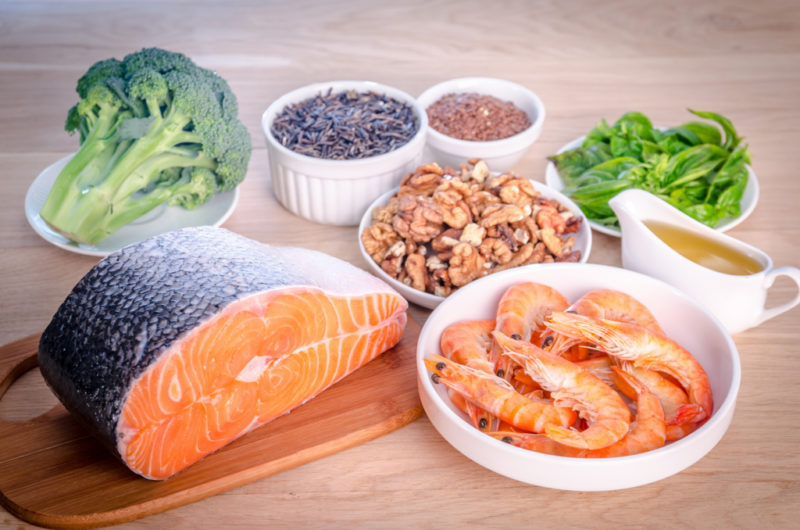
These substances are important not only for health, but also for beauty. Thyroid hormones stimulate the structure and renewal of tissues. The condition of hair, skin and nails is highly dependent on the activity of the thyroid gland.
Iodine-containing products are useful for those whose work is closely related to nervous and mental stress. With sufficient intake of iodine in the body, memory, concentration improves, stress resistance increases, nervous excitability decreases.
Iodine-containing products are beneficial for almost everyone. The exception is people who have removed the thyroid gland. Since with it, receptors that respond to iodine are also lost. Its use becomes meaningless.
Read also: TSH increased - what does it mean for women?
How much iodine does a person need per day?
The younger the body, the more intensively it develops, the more acute need for iodine it feels. Infants younger than one year old and preschool children need 50 and 90 micrograms per day, respectively.

An important role is played by the physiological state. Pregnant and lactating women are the most vulnerable category. They have to provide with an element not only themselves, but also their baby. The daily norm for women during pregnancy and lactation is at least 200 mcg.
Pupils from 7 to 12 years old need 120 mcg of iodine. And adults and the elderly need to consume 150 and 100 micrograms of the element daily. As the body ages, the processes occurring in it slow down, and the need for substances decreases.
Products containing iodine
Knowing which foods contain iodine, you can correctly build your diet. But no matter how hard we try, we won’t be able to accurately calculate the amount of substance.
The reference information indicates the approximate iodine content in the product. How much it actually gets into food depends on many conditions. Take, for example, fish: it matters where it lived, what it fed, and grew under natural or artificial conditions.
Seafood and animal products accumulate more iodine. And plants, especially those growing in endemic territories, contain it in the smallest quantities.
Seafood - List
Among the marine products, the leader in iodine content is cod liver. According to various sources, it contains from 370 to 800 μg of a valuable substance in every 100 g of the product.
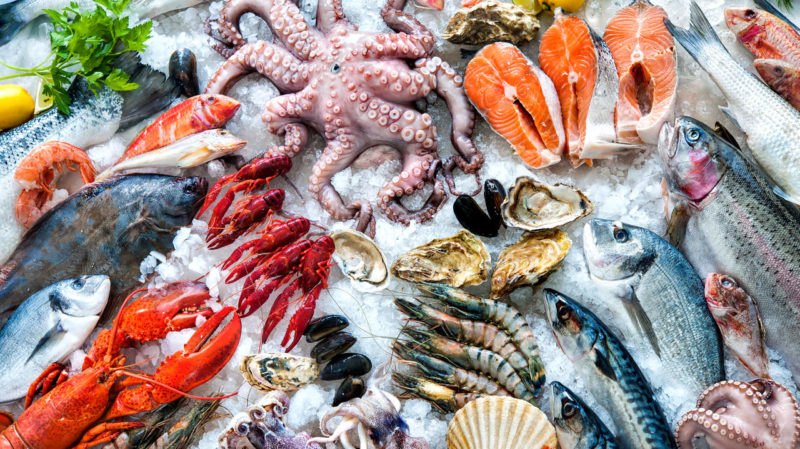
Other seafood is also rich in iodine:
| squid | 300 mcg / 100 g |
| salmon | 220 mcg / 100 g |
| sea kale | 200 mcg / 100 g |
| shrimp | 190 mcg / 100 g |
| sea bass | 145 mcg / 100 g |
| herring | 70 mcg / 100 g |
| tuna | 50 mcg / 100 g |
When compiling a diet, you need to keep in mind that most of the iodine is lost during the cooking of the product.
For example, in 100 g of fried shrimp, only 11 μg of the beneficial substance remains.
Vegetables and cereals containing iodine
The greatest amount of iodine is found in green vegetables and leafy salads. The main advantage of these products is that they can be consumed raw.

The product table is as follows:
| field salad | 65 mcg / 100 g |
| broccoli | 15 mcg / 100 g |
| greenery | 14 mcg / 100 g |
| spinach | 12 mcg / 100 g |
| radish | 8 mcg / 100 g |
| beet | 8 mcg / 100 g |
| cabbage | 7 mcg / 100 g |
| potatoes | 5 mcg / 100 g |
| carrot | 6 mcg / 100 g |
| onion | 4 mcg / 100 g |
| cucumbers | 3 mcg / 100 g |
Cereals also contain a certain amount of iodine:
| beans | 12 mcg / 100 g |
| wheat | 11 mcg / 100 g |
| rye | 9 mcg / 100 g |
| barley | 8 mcg / 100 g |
| soybeans | 8 mcg / 100 g |
| peas | 5 mcg / 100 g |
| corn | 5 mcg / 100 g |
| buckwheat | 4 mcg / 100 g |
But their value in the diet is minimal, as they are forced to undergo prolonged heat treatment.
Berries and fruits with a high iodine content
Despite the fact that berries and fruits do not accumulate a large amount of iodine, they help make up for the deficiency. Iodine not only collapses when heated, but also disappears with time. Therefore, fruit products should be consumed as soon as possible after collection.
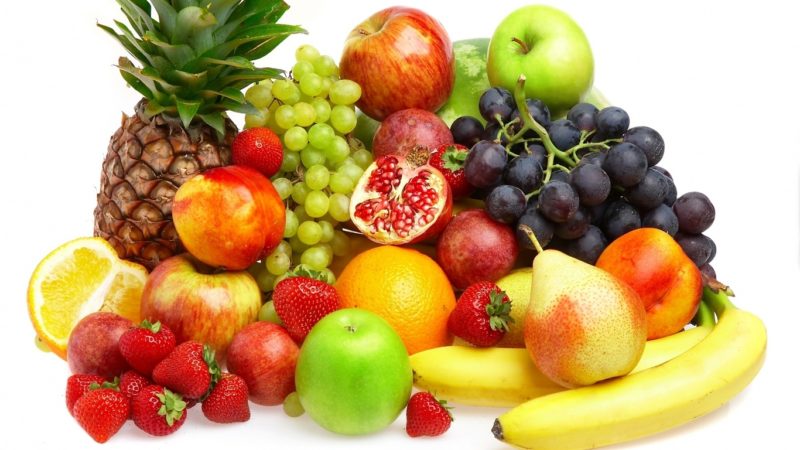
The most iodine-rich fruits and berries:
| feijoa | 70 mcg / 100 g |
| apples | 65 mcg / 100 g |
| persimmon | 27 mcg / 100 g |
| grape | 7 mcg / 100 g |
The remaining fruits and berries contain an average of 2 to 6 micrograms of iodine per 100 g of product.
Animal products
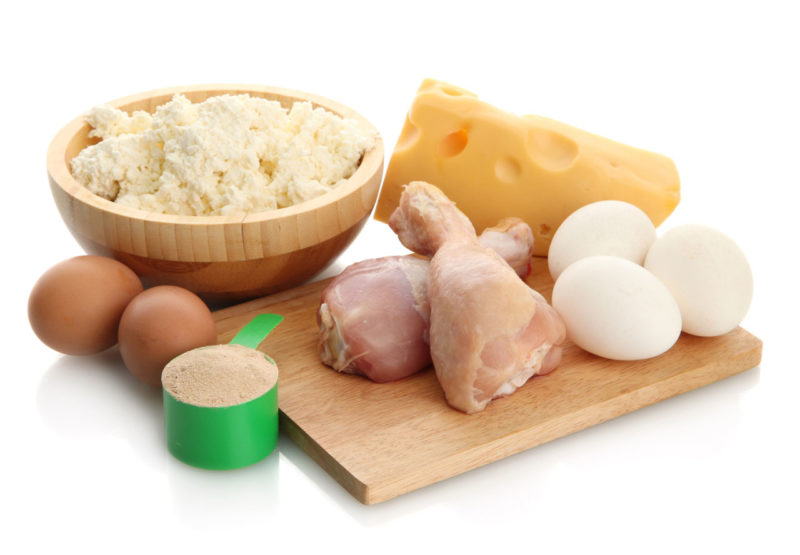
Dairy products will help replenish iodine reserves:
| milk | 16 mcg / 100 g |
| kefir | 14 mcg / 100 g |
| cream | 9 mcg / 100 g |
| sour cream | 7 mcg / 100 g |
| cheese | 4 mcg / 100 g |
| cottage cheese | 3 mcg / 100 g |
Some animal products are also a valuable source of iodine:
| chicken egg | 20 mcg / 100 g |
| beef liver | 7 mcg / 100 g |
| mutton | 5 mcg / 100 g |
| chicken | 4 mcg / 100 g |
| pork | 3 mcg / 100 g |
When choosing a cooking method, one should give preference to the most gentle methods. To preserve iodine, food is best steamed.
Artificially Enriched Iodine Products
If dieting is an individual way to combat micronutrient deficiency, then forced food iodization is considered a mass prevention method. In the late 90s, the Institute of Nutrition RAMS developed standards according to which it is allowed to artificially enrich iodine with products such as salt and bread.
In the production of iodized salt, 4 mg of potassium iodate is added per kilogram of raw material. It is estimated that an average adult consumes about 1 teaspoon of salt. If approximately half of the iodine is lost during cooking, then together with the artificially enriched product, the consumer will receive about 150 micrograms of the useful substance, which will correspond to the daily norm.
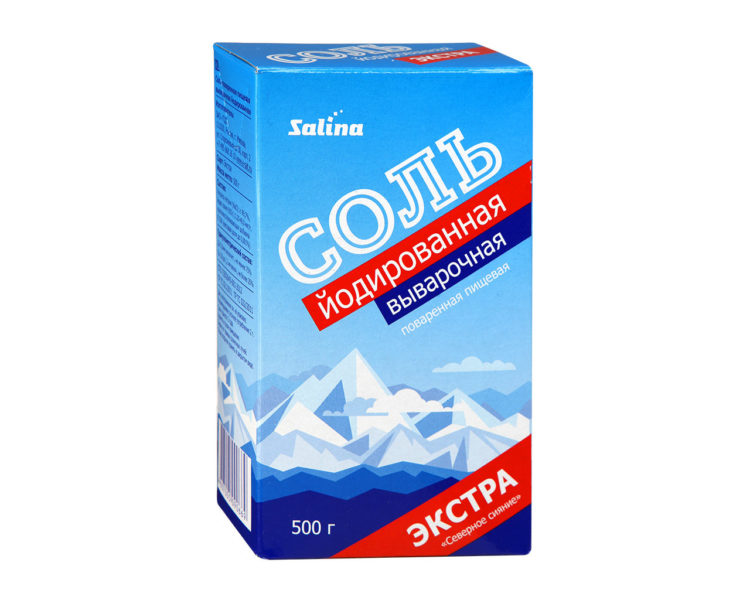
When enriching bread, potassium iodide is added directly to flour at the initial stage of baking. And subsequently, 300 g of such a finished product contains about 110 μg of iodine.
Artificially fortified foods can become part of the diet. To taste, it does not differ from similar, unenriched products. Nothing prevents it from being consumed in the usual amounts.
The list of products saturated with iodine is quite large. Therefore, to create a diet that would meet individual taste preferences is not difficult. Remember that it is organic iodine, which is contained in food, that is better absorbed. Vegetables and fruits are best eaten raw, and products of animal and marine origin are steamed.












